




Randolph County Board of Commissioners
David Allen, Chairman
Darrell Frye, Vice Chairman
Stan Haywood
Randolph County Tourism Development Authority
David Caughron, Chairman
Mary Joan Pugh, Vice Chair
Gail Morgan, Board Member
Barbara Gallimore, Board Member
Rebecca Petty Moffitt, Board Member
Shawn Patel, Board Member
Deep River Trail Task Force
Perry Connor, Town of Franklinville
Jay Dale, County of Randolph
Jesse Day, Piedmont Triad Regional Council
Tom Jordan, Cedar Falls Community
Kerri Lindley, Town of Ramseur
Trevor Nuttall, City of Asheboro
Tammy O'Kelley, Executive Director
Greg Patton, City of Randleman
Jim Plant, At Large
Consulting Staff, Piedmont Triad Regional Council
Jesse Day, Regional Planning Director
Malinda Ford, GIS Manager
Joe Furstenberg, Regional Planner
Kenny Kidd Maxton McDowell
Ross Holt, Board Member Luke Hollingsworth, Board Member
Marianne Rowe, Board Member
Tammy O’Kelley, Executive Director
Amber Renee Skeen, Clerk to the Board
Mary Joan Pugh, Task Force Chair
Smith Raynor, NC State Parks
Regional Trails Specialist
Amber Renee Skeen, Clerk to the Task Force
Jim Rich, A3 Healthy Communities
April Thornton, Randolph Hospital Foundation
Mac Whatley, RC Historic Landmark Preservation Commission
Mac Whatley, RC Historic Landmark Preservation Commission
Elizabeth Jernigan, Assistant Planning Director
Kelly Larkins, Regional Planner II
Anna Leonard, Environmental Programs Coordinator
The Deep River became a State Trail in 2007 through special legislation in the General Assembly The authorization did not provide funding to implement the trail, but did give priority for communities along the river who may want to access recreation trail grants to construct and maintain trail in the corridor. Soon after, the City of Randleman and the Town of Franklinville opened sections of trail along the Deep River. The Town of Ramseur also secured a Clean Water Management Trust Fund grant to complete a detailed alignment of the trail in the Town of Ramseur.
In 2015 a Deep River Trail Task Force was formed by the Randolph County Tourism Development Authority with local, regional, and state government representatives as well as recreation and trail advocates to continue coordinating efforts for planning, design, construction and management of the Deep River Trail in Randolph County. A task force report was completed in 2016 inventorying the status of trail development along the Deep River, while also providing recommendations on key plans, designs and other actions to move trail development forward. The completion of this Deep River Trail Conceptual Plan , provides alignment alternatives and recommendations for the proposed Deep River trail from Randleman to Ramseur. The recommendations are divided up into the following six sections, which also correspond to the map.

Randleman to Worthville 3 Miles
Worthville to Central Falls 3 Miles
Central Falls to Cedar Falls 3 miles
Cedar Falls to Franklinville 2.75 miles
Franklinville to Ramseur
Ramseur
miles
miles
The Deep River Trail Task Force developed broad goals, barriers and opportunities for trail development in the spring of 2017.
Why is the Deep River Trail important for your community, the County and the region? It will…
Improve quality of life,
Expand recreation and economic
health and fitness,
the environment,
tourism, recreation
identity
nature and education,
young families,
to attract new citizens,
natural areas along the river from development, and
citizens and visitors about the history of the river.
The Deep River Trail will connect communities all along the Deep River. The trail will be an anchor for recreation and tourism in Randolph County, connecting people with nature and the river. The trail will be easily accessible for the community at large and will connect to other local, regional & State trail networks. The Deep River Trail will be used as an alternate form of transportation and provide a place for visitors and citizens to exercise, recreate, and experience the outdoors on the Deep River.
How can the barriers to and opportunities from trail development be addressed?
Barriers: Landowner opposition, funding, few existing trails, major creek crossings
Opportunities: Blueway trails and dam portages, economic benefits, tourism, health, fitness and recreation

Barriers & Opportunities with Example Strategies
1. Explain the vision of the Deep River Trail to as many audiences as possible
o Gather community partners and deliver presentations.
o Work with landowners individually and discuss the vision of the trail.
2. Implement a County property tax benefit and explain State and federal tax incentives for trail easement dedication
o Dedicate funding for legal costs of easement acquisition.
3. Incorporate trail easement dedication through the subdivision process for adopted trails for Randolph County, Randleman, Asheboro, Franklinville and Ramseur
4. Develop public and private funding sources for trail and bridge design and construction
o Leverage grant opportunities from State (e.g. tourism or NCDOT) and private foundations.
5. Develop river access and trail in the middle section of the Deep River (e.g. Central Falls and the landfill property)
o Acquire easements now where trail alignment is known (e.g. along rail bed),
o Build trails on County landfill property, and
o Get further sections of trail completed to gain momentum and educate citizens on trail potential.
6. Creek crossings
o Complete engineering studies to know the length and design constraints of bridges
o See how the Sandy Creek bridge crossing design study can be a model for other large crossings (e.g. Harlan’s Creek, Bush Creek, Gabriel’s Creek)
o Select crossing locations with least impact to floodplain and sensitive areas
7. Focus on river blueway and portage trails around dams
o Construct a boat launch in the Old Liberty Road Area and
o Connect the river to RCC, local campgrounds and churches.
8. Promote economic development and benefits (e.g. Virginia Creeper Trail)
o Low cost infrastructure,
o Take an economic “snapshot” prior to construction and monitor economic benefits (e.g. sales tax, room tax and trips) after the trail is complete, and
o Highlight studies of economic benefit related to trails development.
9. Advertise nature tourism
o Continue to market the trail to hikers, walkers and families and
o Promote through outfitter and restaurant partnerships and signage
10. Market health, exercise and passive recreation benefits of trail implementation
11. Expand the work of the Deep River Trail Task Force
o Conduct stewardship programs on the Deep River including stream and river clean ups,

o Conduct private fundraising campaign providing matching funds for private, local, state and federal grants, and
o Work with willing landowners to acquire trail easements.
12. Seek adoption of the Deep River Trail Conceptual plan by Randolph County, Randleman, Asheboro, Franklinville and Ramseur
The Deep River Trail is envisioned to be a multi use trail and blueway alongside the Deep River and through communities once supported by the rail line, textile manufacturing, and the river. Though the steel rails, wooden cross ties and river barges were removed decades ago, it is easy to see where industry and commerce once thrived along the river.
The trail will connect small towns and communities in new ways, allowing participants to reconnect to the remnants of history and culture along the abandoned rail line and mill villages that relied on the river for power. The trail will offer citizens a chance to get out of their cars and experience the outdoor luxuries of trees, shade, birdsongs, and views of the scenic Deep River. It will be a haven for walkers, cyclists, runners, paddlers and families away from the noise of vehicular traffic. The trail provides an important link in a developing multi county trail system.
In 2007, legislation was passed authorizing the establishment of “The Deep River State Trail” as part of the state park system. The State Trail would encompass a network of conservation lands and recreation features including trails, water access, parks and other amenities stretching along the Deep River corridor from its headwaters in Guilford County through Randolph, Chatham, and Moore Counties down to the confluence with the Cape Fear River.
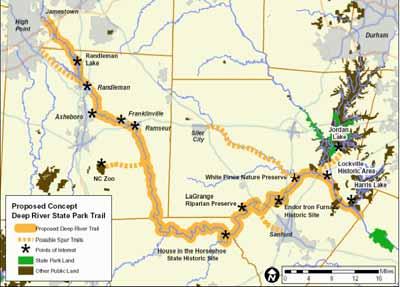
A safe place for outdoor physical activity: Few rural communities have access to safe places to walk or bicycle. Rail trails provide opportunities to be active without interacting with motorized traffic. Because rail lines were once major transportation corridors, they connect communities to town and community centers.
A place to enjoy nature: Trails and greenways often provide wildlife habitat. The location of the rail trail along the Deep River will preserve its riparian buffer. The mature vegetation and wooded forests that make up the riparian corridor provides critical habitat for terrestrial and aquatic species, providing a unique wildlife viewing experience.
A place for recreation: The trail connection from Ramseur to Franklinville will offer varied walking, running and bicycling distance options for residents from each town. Twenty minutes of elevated heart rate per day can provide a tremendous benefit to human health and fitness. In addition to walking and bicycling, the trail will also access locations for picnicking, fishing, and will provide canoe/kayak sites designated as part of the State Park Deep River Trail.
More transportation options, lower transportation costs, and cleaner environment: The trail will develop safe, reliable, and affordable transportation choices that reduce energy consumption, and improve air quality. The trail when fully implemented will connect communities to their schools giving children a safer route to walk or bicycle to and from school.
Valuable asset for communities and neighborhoods : The trail will be a unique asset to the communities and neighborhoods adjacent to the trail. There are several studies that indicate property values increase when adjacent to trails.
Economically viable/sustainable community development: Trails are an excellent way to increase community revitalization. Companies increasingly seek communities that provide amenities that enhance employees’ quality of life. Trails and greenways are one of the most sought after amenities. Longer trails offer a regional draw for tourism as well. And this trail will link up with a network of other trails and greenways and act as a cornerstone for regional economic competitiveness.
The Deep River is rich in historical importance for both the development of Randolph County and the North Carolina Piedmont region.
The earliest known humans to settle in the area were visited in 1701 by the English explorer John Lawson, who recorded his encounter in a book titled “A New Voyage to Carolina” published in 1709. As Lawson traveled through the Carolina backcountry for the colonial authorities, his small expedition came across a Native American tribe called the Keyauwee or Caraway.
In part due to the interest generated by Lawson and other explorers, the Province of North Carolina saw an increasing number of English, Scotch Irish, and German pioneers who began settling and establishing farms and mills in the area. This domestic peace was later shattered by the outbreak of war between the Colonies and Great Britain, with Randolph County and the Deep River providing a backdrop to several skirmishes between Patriots and Loyalists. After the war, the strong flow of the Deep River provided resourceful citizens with the necessary energy to begin powering mills. These developments not only improved the lives of those who built and ran the factories, but it also helped bring Randolph County into the Industrial Revolution. Starting in 1836, factories began to appear in Cedar Falls, Randleman, Franklinville, and Ramseur making Randolph County one of three of the largest centers of manufacturing in the state by the outbreak of the Civil War. By the 1880’s, more factories sprung up in communities such as Worthville and Central Falls. In the early 20th century, the factories in these communities were served by a gasoline powered barge with the main purpose of shuttling raw cotton down river to be dyed.

Field work was conducted by boat and by foot between January and April 2017. Cameras equipped with GPS systems were used to gather natural and cultural features along the study corridor. Areas along the river were investigated for trail constructability. Factors affecting constructability include wetlands, existing structures (homes, utilities, dams and businesses), stream outlets to the Deep River, roads, topography and landfill operations. Each part of the corridor has unique opportunities and challenges for design, construction, management and maintenance based upon the varying conditions of the corridor.
In addition to the efforts to construct trail in Randleman, Franklinville and Ramseur, other plans were reviewed to inform this Conceptual Plan. The following plans reference the Deep River Trail:
Deep River Trail Task Force Report (2016)
Trail inventory and action plan for the Deep River Trail Task force and partners, foundational document for this Conceptual Plan
Randolph County Strategic Plan (2016)
Example strategy for Well Being and Quality of Life: Coordinate with partners to market and brand the developing Deep River Trail
Piedmont Triad Trails Inventory (2011)
Identifies the Deep River State Trail and other proposed trails in Randolph County as part of a larger regional & State trail network.
Deep River Rail Trail Master Plan (2011)
Detailed alignment, cost estimates, surveys and other information on Section 6 (Town of Ramseur and Clean Water Management Trust Fund) of this Conceptual Plan.
Randolph County Growth Management Plan (2009)
Policy recommendations include supporting tourism and land development that preserves and protects water quality.
Other municipal planning and committee efforts have also helped to inform and educate citizens and government staff on the history, culture and ecological uniqueness of the Deep River corridor. Each grant application, committee meeting, public event has moved the trail development forward. This Conceptual Plan will build from the progress already made over the last decade to plan, design and implement trail sections.

A number of potential outdoor recreational opportunities including fishing, canoeing/kayaking, and swimming could grow. There is limited advanced or technical water to attract expert paddlers, but the Deep River provides ample opportunities for beginner paddlers and groups. New swimming areas like the one planned at the old Worthville mill and dam will provide new public recreation opportunities on the Deep River.
The natural surface multi use trail constructed by the City of Randleman and the Town of Franklinville offer trail experiences on either end of the conceptual plan study area. Franklinville’s section is on a former rail bed providing a very accessible pathway. The City of Randleman offers a mix of a wide and flat trail to more technical hiking trails sections. The City of Randleman and Town of Franklinville have both utilized Clean Water Management Trust Fund, Recreation Trails Program and additional funding sources to build trail sections.
The North Carolina Zoo is not in the immediate vicinity of the study area, however the Zoo has been and continues to be a tourism draw for Randolph County. Partnerships in recreation marketing, branding and programming will be an ongoing opportunity for increasing recreation users on the Deep River Trail as it is implemented.
The County and Randolph Community College own a large part of the land in Section 3 of the study area from Central Falls to Cedar Falls. This middle section has no trail or publicly accessible points on the river, making it a prime opportunity to demonstrate the benefits of public recreational access on the Deep River. Other sections, including many in Franklinville and Ramseur have acquired trail easements or purchased property for trail development.
There are six dams in the study area, two of which are actively generating electric power. The other four dams have either been breached slightly or the hydro electric equipment has not been maintained. More detail is provided below for each section in Feasibility Analysis & Preferred Trail Alignment
There are parts of Section 2 and 3 that have significant wetland challenges close to the Deep River. Either re routing or low impact boardwalk construction will be necessary to complete trail in these areas.

There are several large creek tributaries of the Deep River that will provide challenges to trail implementation. Some of the largest creek crossings include Haskett’s, Gabriel, Sandy and Harlan’s Creek crossings require a 50 ft or longer bridge to cross. Alternative trail alignment options for crossing at these locations are suggested to either minimize environmental impact or construction costs.

There are several mills and villages in study area. Three active mills; Prestige Fabricators (Central Falls) and Sapona Mill (just downstream of Cedar Falls) and Deep River Fabricators (Franklinville) continue to operate, but many others have been shuddered in the last few decades. The section between Cedar Falls and Ramseur used to have an active rail line that supported the mills and additional industrial development along the corridor. It has been over 30 years since that rail line was removed, tracks and bridges included. In some streams the piers for the bridges remain, which following inspection may be used to support a pedestrian bridge. Additionally, residential development, boat and truck repair businesses, civic organizations, active and inactive landfills, an RV Park and some additional small scale commercial development are located in the study area.
The Deep River is located in the Cape Fear River Basin, the largest river basin in North Carolina. Major drainages in the basin include the Haw River, Deep River, Northeast Cape Fear River and Black River.
The NC Wildlife Resources Commission Wildlife Action Plan addresses local, regional, and state wide concerns across key terrestrial and aquatic habitats and identified critical knowledge gaps and future data needs.
The Upper Cape Fear River Basin is included in this plan and documents aquatic resource conditions, aquatic species, threats to aquatic species, and basin specific recommendations. There are 35 species of greatest conservation need (SGCN) in the basin: two aquatic snails, two crayfish, 18 freshwater or anadromous fishes, and 13 mussels.
Access to the Deep River and historic spawning habitats in the upper Cape Fear River basin is currently blocked by Lockville Dam near the mouth of the Deep River. Fish passage around these obstructions is needed for migratory fish to reach historic spawning sites in the Deep River. Restoring migratory fish access to historic spawning and nursery habitats will help rebuild currently depressed populations to support healthy ecosystems and sustainable recreational and commercial fisheries
The Wildlife Action Plan recommends long term monitoring to assess species and ecosystem health over time. These efforts will inform species and habitat management decisions. The state plan supports well planned stream restoration, dam removal, and identifying conservation areas critical to aquatic ecosystem health.
A query of the North Carolina Natural Heritage Program (NCNHP) database indicates records for rare species within the proposed project boundary. The rare species listed in Table 1 have been documented within a one mile radius of the Deep River between Randleman and Ramseur. The proximity of these records suggest these NHP elements may potentially be present in the project area if a suitable habitat exists.
Figure
Schweinitz’s sunflower is a fall blooming plant native to the Piedmont region of
found in only 12

Section Distance: 3 Miles; Completed Trail: 1.5 miles; Funded Trail: 1.5 miles
Preferred Alignment: Southwest side or river right
Stream Crossings: 3 (Map ID 1 ‐ 25ft, 2 25ft, 3 25ft, estimated distance)
Summary: This section starts in the City of Randleman where 1.5 miles of existing trail begins at N. Main Street and the Deep River. The trail is on the southwest side of the Deep River. Funding has been secured for implementing 1.5 miles of trail to get to the closed Worthville Mill. As shown in the pictures below, there are topographic challenges to constructing the trail along this corridor, including rock outcroppings and streams. The trail will meander and narrow in some of these locations, but will eventually tie into the Worthville Mill and village area. The historic Worthville mill village will be connected via trail to the City of Randleman. Grants and land acquisition around the old Worthville mill and dam, will create a destination for trail users.
Continue to utilize Recreation Trails Program and Duke Energy foundation funding to acquire easements and implement trail development towards Worthville;

Seek grant funding to develop recreation improvements (e.g. swimming, boat access and picnicking) adjacent to the trail near Worthville dam; and
Continue to market the existing sections of trail and plan for pedestrian improvements along roadways that connect downtown Randleman to the Deep River.










Section Distance: 3 Miles; No Completed Trail
Preferred Alignment: Southwest side or river right
Stream Crossings: 3 (Map ID 4 30ft, 5 35ft, 6 75ft, estimated distance)
Summary: This section begins below the Worthville Mill and Dam. The City of Randleman has acquired approximately 157 acres immediately downstream from the old mill, with opportunities for recreation including swimming access and trail development. Going downstream, privately held land exists on both sides of the river to Central Falls. Land trail feasibility was primarily investigated on the southwest side of the river where Worthville and Central Falls villages are located. The middle of this section on river right includes a large wetland area, providing challenges to implementation. More groundwork following discussions with willing landowners will inform the trail routing through the wetlands area. The route for the trail is located along WOW Road, which should be improved to create a paved shoulder on both sides of the road for automobile, pedestrian and bicycle safety.
Key Steps:
Work with NCDOT, the Piedmont Triad RPO and Randolph County to prioritize paved shoulder improvements on WOW Road between Worthville and Central Falls in the State Transportation Improvement Program (TIP) or other transportation funding programs;
Work with willing landowners to acquire trail easements adjacent to the Deep River; and
Develop a public swimming beach and boat access below the Worthville Dam on publicly owned land.






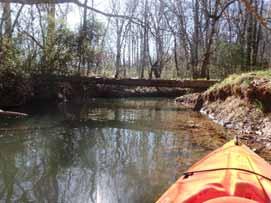




Section Distance: 3 Miles; No Completed Trail
Preferred Alignment: Southwest side or river right; Alternate Alignment: Portions on the northeast side or river left.
Stream Crossings: 10 (Map ID 7 50ft, 8 25ft, 9 20ft, 10 17ft, 11 12ft, 12 35ft, 13 20ft, 14 45ft, 15 360ft, 16‐ 30ft)
Summary: This section of trail has one active dam, Cox’s dam. Just downstream of Central Falls towards Cedar Falls is publicly owned land owned by Randolph County or Randolph Community College. All of the publicly owned parcels are located on the southwest portion of the river. The majority of the land use on the publicly owned land is the former landfill, which serves as a transfer station. Another large part of the publicly owned land has been leased to Waste Management for an active landfill, but provides for a 300 foot buffer along the Deep River. As the corridor gets closer to Cedar Falls, topography and geology gets hillier, where bluffs along the river make it difficult to access the river from the land adjacent on the southwest side of the river. The northeast side of the river may provide better construction options, however there is active farming and all privately held land south of Cox’s dam on the northeast side or river left. An alternate route has been suggested on the northeast side of the river (river left).
Key Improvements:
Develop a public boat access and trailhead downstream from Old Liberty Road on land owned by the City of Asheboro near the Shriner’s Club;

Design and build trail on the old and new landfill property, connecting with the RCC campus, where a trailhead is proposed;
Explore purchase of Cedar Dam and island for park and water access;
Work with willing landowners to acquire trail easements;
and determine feasibility
alternative trail routes to connect with Cedar Falls.










Section Distance: 2.75 Miles; No Completed Trail
Preferred Alignment: Northeast side or river left
Stream Crossings: 1 (Map ID 17 125ft)
Summary: This section of the Deep River has an abandoned rail line on the northeast side of the river. The rail line was abandoned and tracks removed over 30 years ago. The rail bed property has reverted back to private ownership in this section. The Cedar Falls village is where the rail line turned north and away from the Deep River. Sapona Mill is an active manufacturing facility just downstream from Cedar Falls on the northeast side of the river. Bush Creek is a major stream crossing likely requiring a detailed design and floodplain impact study, however this crossing is not currently publicly owned. The Franklinville Upper Mill Dam is still actively generating power. Not much of the Franklinville Lower Mill Dam remains as it is completely breached, with much of the infrastructure removed. Just downstream of where Andrew Hunter Road crosses the Deep River in Franklinville there is a pedestrian bridge that takes hikers across the Deep River to Faith Rock. A natural surface hiking trail approximately 3/4 mile long takes hikers to and along Faith Rock, a significant natural and cultural feature of the Deep River. A parking area for the Faith Rock trail is available adjacent to Andrew Hunter Road in the Town of Franklinville and another access is off of Faith Rock Road on the southwest side of the river.
Work with NCDOT, the Piedmont Triad RPO and Randolph County to prioritize paved shoulder improvements on Cedar Falls Road from Loflin Pond Road to Mill House Lane, utilize Mill House Lane to connect with the abandoned rail line south and east of the active Sapona Manufacturing facility and

Work with willing landowners to acquire trail easements along the abandoned rail bed.










Section Distance: 2 Miles; Completed Trail: 1 Mile, Funding Pending for 1 mile of trail
Trail Alignment: Northeast side or river left
Stream Crossings: 1 (Map ID 18 115ft)
Summary: This section begins at Riverside Park in Franklinville. Just downstream, much of the Franklinville Lower Mill Dam is completely breached with some dam material removed. The Town of Franklinville constructed one mile of trail along the old rail bed. The Town of Franklinville has funding to complete the trail from Sandy Creek to Riverside Park. The crossing of Sandy Creek to Ramseur has been an ongoing challenge to physically connect. The old rail crossing is over 200 feet and alternate crossings are likely 85 feet or more.
Key Improvements:
Secure pending Recreational Trails Program grant to complete the Deep River Trail that will connect Sandy Creek to Riverside Park in Franklinville.
Complete a proposed alignment, design and floodplain analysis of the Sandy Creek bridge in 2017 and 2018. Randolph County has provided funding for the design and additional funds to leverage grants for construction of the bridge.
Continue to promote the existing trail and invite citizens and community leaders along the Deep River to walk the existing trail





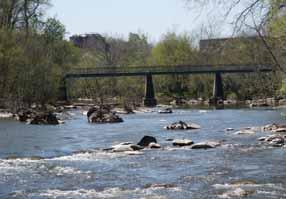
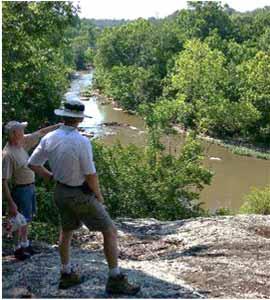
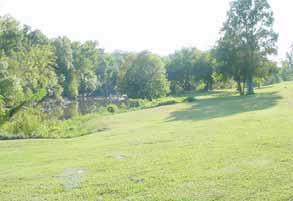



Section Distance: 1.25 Miles; Partially completed trail between Sandy Creek & Harlan’s Creek
Trail Alignment: Northeast side or river left
Stream Crossings: 1 (Map ID 19 – 195ft)
Summary: This 1.25 mile section of proposed trail had a detailed trail study completed in 2011. The recommended surface from the plan is crushed granite millings at a width of 10 feet. Between the trailhead at the old boat landing and Harlan’s Creek, easements for the trail have been acquired by the Town of Ramseur. Surfacing material has been placed between the old boat landing and Harlan’s Creek to increase accessibility.
There is one major stream crossing with rail trestle piers still in place, over Harlan’s Creek; the decking has been removed (see P3 photo). These piers appear to be in good enough condition to be reused, but will need to be analyzed by a structural engineer to determine if a pedestrian bridge could be constructed on them. The good condition of the rail bed should require less grading/grubbing and base material for trail construction than usual.
Key Improvements:
Acquire the final easement for trail development along the old rail bed just downstream from Harlan’s Creek.
Secure funding for construction of the Harlan’s Creek bridge, a key connection for this section of trail
Improve trailhead parking and signage off US 64 to create better access to the existing trail
Re establish a Town committee to keep the existing trail cleared and maintained.










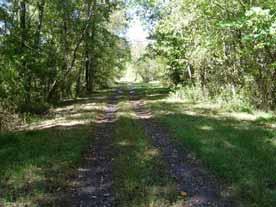

Randleman Park to Worthv ille Dam (2.4 miles)
Level of Difficulty: Class 1
Portage: Worthville Dam, river right/southwest side
Key Improvements: Signage, access ramps/steps and trail surfacing improvements.
Worthville Dam to Cox Dam (5.8 miles)
Level of Difficulty: Flat
Portage: Cox Dam, river right/southwest side
The blueway trail will require physical improvements and access easements from willing landowners where noted. These descriptions are intended to advise blueway trail improvements, not to guide paddlers along the Deep River.
Key Improvements: Signage, access ramps/steps, a bridge over Cox Creek, trail surfacing improvements and trail easement from private landowner.
Cox Dam to Cedar Falls/Loflin Pond Road (0.5 miles)
Level of Difficulty: Class I, II, III
Portage: Cedar Falls Dam and falls, river left/northeast side*
Key Improvements: Signage, access ramps/steps, trail surfacing improvements and trail easement from private landowner.
*Experienced paddlers may choose to float Cedar Falls below the dam, however a portage to Loflin Pond Road may be necessary for less experienced paddlers or in low water conditions.
Cedar Falls/Loflin Pond Road to Andrew Hunter Road (2 miles)
Level of Difficulty: Class I, II
Portage: Franklinville Upper Mill Dam, river left/northeast side**
Key Improvements: Signage, access ramps/steps, trails surfacing improvements and trail easement from private landowner.
**Portage will require a ¼ mile carry to get across Andrew Hunter Road
Andrew Hunter Road to US 64/Sandy Creek (2.3 miles)
Level of Difficulty: Class II
Portage: Depending on the water level, the Franklinville Lower Mill Dam may require a portage river left/northeast side, however it can be floated in most conditions.
Key Improvements: Signage and boat access improvements at Franklinville Park pedestrian bridge needed. Trail access easements needed upstream from Andrew Hunter Road.
US 64/Sandy Creek to Brooklyn Bridge (1 mile)
Level of Difficulty: Flat or Class I
Portage: Ramseur Dam, river left/northeast side
Key Improvements: Signage, access ramps/steps, trails surfacing improvements. Alternate take out above Ramseur Dam on river right/southwest side at the Leonard Memorial Park.
The following list shows recent strategic steps taken and actions steps for the next 12 18 months to assist in implementation of the Deep River Trail. The Deep River Trail Task force will be instrumental in assisting with implementing the action steps listed below.
Randleman Construct Phase I Trail from Randleman Park to E. Naomi St. In progress. Randleman Construct Phase II Trail from E. Naomi St. to Worthville Dam. Funded.
Randleman Acquire property down stream of Worthville Dam. Complete.
Central Falls to Cedar Falls Work with Randolph County Administration, Community College and Waste Management on trail along publicly owned property. Funding needed. Detailed trail alignment to be completed with master trail builder.
Central Falls to Cedar Falls
Explore purchase of Cedar Dam and island for park and water access. Present a proposal to the Piedmont Triad Water Authority for purchase.
Franklinville Acquire Faith Rock property and new trail to add to Riverside Park. Complete Franklinville Construct segment connecting existing Deep River Rail Trail to Riverside Park. Funding requested Franklinville Design and construct bridge over Sandy Creek. Construction project cost and ranking submitted to NCDOT by the Piedmont Triad RPO Engineering study and environmental assessment and estimated 10% of bridge construction funding secured Ramseur Construct Rail Trail from Boat Landing to Harlan’s Creek. Complete. Ramseur In partnership with State Parks, acquire parcel just downstream from Harlan’s Creek to complete easement and acquisition for trail development. In progress.
Improve small boat access at Worthville Dam and implement Central Falls small boat access. Design boat landings and complete environmental analysis for floodplain impact.
Hold a historical barge and boat regatta between Worthville and Central Falls to highlight the former company ships that ran between mills. Present idea to Randolph Historical Society for input and partnership.
Cedar Falls/Loflin Pond Rd to Andrew Hunter Rd. Work on access location.
Andrew Hunter Rd to Franklinville Park. Work on access.
River clean ups on different sections of the river. Conduct spring and fall clean up events.
Implement portage improvements around dams. Seek grant funding for dam portage trail improvements and seek easements from willing landowners where required.
Continue Stormwater education programs in schools through Stormwater SMART. Partner with Stormwater SMART, a stormwater education program.
Continue river clean ups for different sections of the Deep River. Partner with Keep Randolph County Beautiful, Waste Management and other civic partners.
Explore the establishment of a Deep Riverkeeper program to organize river clean ups, advocate for river health & rehabilitation. Establish public/private partnership with existing organizations
Continue to share best practices for maintenance between each town and participate in trail conferences to develop new techniques and innovations. Participate in Piedmont Legacy Trails annual conference and resolution of support.
Conduct and share trail counts and surveys to understand how people are using the developing Deep River trail. Provide comment request forms at trailheads to allow feedback on trail improvements.
Provide information to trail users on how to report maintenance issues along trail sections. Establish mile markers or other location information, share and coordinate with Randolph County EMS and local law enforcement.